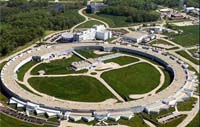 |
 |
|
||||||
| Home
| Mission
|
about SciDAC
|
Contact Us |
||||||
|
SCIENTIFIC DISCOVERYCEDPS success with caBIG and APS beamline
|
||||||||||||||||||||||||||||||||||||||||||
  |
Under the leadership of Ravi Madduri, member of the SciDAC CEDPS project, Argonne software developers have designed and implemented several innovative technologies in the caBIG architecture and have developed a collaborative information network to enable interoperability among biomedial databases and analytical tools.
The tool called gRAVI (grid remote application virtualization interface, pronounced "gravy") along with Introduce toolkit (part of the caGrid toolkit) provides a framework to enable fast and easy creation of Globus based grid services (while hiding all "grid-ness" from the developer). It addresses service support features such as: advertisement, discovery, invocation, and security (Authentication/Authorization. It allows researchers to wrap executables, applications as Grid services without writing a single line of code and thus reducing barrier to entry for researchers to expose their applications as services promoting reuse.
The caBIG initiative is a four-year project, funded by the National Cancer Institute, with the mission of linking the more than 60 cancer centers across the U.S. into an integrated distributed-computing system. There are over 900 caBIG participants accessing 45 different services through caGRID.
The new infrastructure for caBIG, called caGrid, uses gRAVI for creating, registering, discovering, and invoking analytical routines as Grid services. Authorized researchers nationwide can invoke these services and compose multiple services into workflows for individual applications. The infrastructure also allows one to create a common gateway service between the caGrid and the TeraGrid, which integrates high-performance computers, data storage, and high-end experimental facilities around the country. This new gateway service, bridges caGrid authentication and authorization processes to the TeraGrid security services, so users can easily access the resources of the TeraGrid without having to modify their applications.
The toolset is finding fame in application areas outside of SciDAC, from the caBIG cancer researchers, who have given several awards to the Argonne project team, to experimental researchers like Brian Tieman of the Advanced Photon Source.
At a recent workshop on lightweight tools for collaborative science, Tieman reported that use of gRAVI has shortened his development time for new services from over a month to around two days. Tieman is generating services that control a beamline experiment, and the data analysis, visualization and modeling that follow on. In addition to the shorter development time, Tieman says gRAVI provides security for jobs, and tracks when his remote job finishes, “and science just happens”.
For more details on the gRAVI project, see the wiki,
for more about the caBIG awards see Argonne highlight
 |
Steve Cotter, who has 10 years of experience in designing and deploying research and commercial networks at the national and international scale, has been named as the new head of ESnet, the Department of Energy’s high-speed network supporting science around the world.
Cotter, who most recently served as Google’s network deployment manager for Europe, the Middle East and Africa, assumes his new job on Friday, August 29. Before joining Google in 2007, Cotter worked for Internet2, a high performance network serving more than 300 institutions in the research and education community in the U.S. Since 2006, ESnet and Internet2 have worked as partners in building ESnet’s next-generation infrastructure. Cotter succeeds Bill Johnston, who is retiring from Berkeley Lab after more than 35 years.
“Steve Cotter brings to this job exactly the right combination of experience in all aspects of network design, development, deployment and operation,” said LBNL Associate Laboratory Director Horst Simon. “On top of that, Steve is already familiar with ESnet’s staff and operations and has strong connections to the research network community. We are thrilled by his decision to lead ESnet.”
ESnet, or the Energy Sciences Network, is managed by Lawrence Berkeley National Laboratory for the Department of Energy. ESnet provides direct connections to more than 40 DOE sites, as well as fast interconnections to more than 100 other networks. Funded principally by DOE's Office of Science, ESnet services allow scientists to make effective use of unique DOE research facilities and computing resources, independent of time and geographic location.
full press release
Argonne's Blue Gene/P Named World's Fastest for Open Science
While the Blue Gene/P has a peak-performance of 557 Teraflops, Intrepid achieved a speed of 450.3 Teraflops on the Linpack application used to measure speed for the Top500 rankings. "Intrepid's speed and power reflect the DOE Office of Science's determined effort to provide the research and development community with powerful tools that enable them to make innovative and high-impact science and engineering breakthroughs," said Rick Stevens, associate laboratory director for computing, environmental and life sciences at Argonne. "Scientists and society are already benefitting from ALCF resources," said Peter Beckman, ALCF acting director. "For example, ALCF's Blue Gene resources have allowed researchers to make major strides in evaluating the molecular and environmental features that may lead to the clinical diagnosis of Parkinson's disease and Lewy body dementia, as well as to simulate materials and designs that are important to the safe and reliable use of nuclear energy plants." Eighty-percent of Intrepid's computing time has been set aside for open science research through the DOE Office of Science's (SC) highly select Innovative and Novel Computational Impact on Theory and Experiment (INCITE) program. There are currently 20 INCITE projects at the ALCF that will use 111 million hours of computing time this year. SC's Office of Advanced Scientific Computing Research provides high-level computer power focused on large-scale installation used by scientists and engineers in many disciplines. For more details, see the "Argonne Press Release" |
Home | ASCR | Contact Us | DOE disclaimer |
|
|